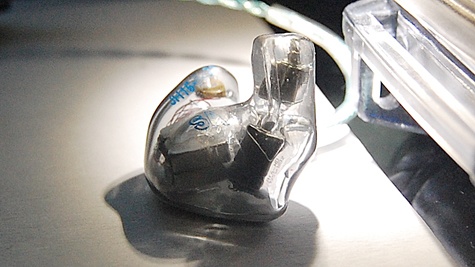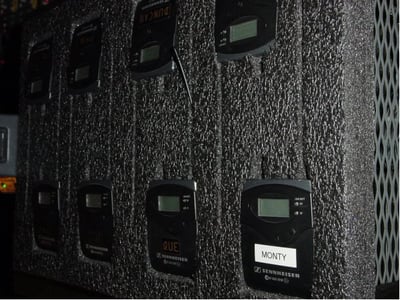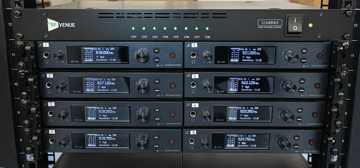The Ultimate Guide to In-Ear Monitors, Straight from the World’s Best Monitor Engineers

Bar none, in-ear monitoring is the most tempermental component of a wireless audio rig. Countless times, we’ve heard customers say, “our wireless microphones and intercoms operate great, but our in-ears drop out all the time.”
We reached out to four of the best, and we do mean the very best, monitor engineers in the live sound industry and asked them why IEMs fail, and how to make them work.
First, meet our contributors (whose pictures above are in order of their appearance below):
David Skaff. Dave was U2’s monitor engineer for 25 years. He also mixes or has mixed monitors for many megabands at Clair Global, where he is currently Chief Audio Systems Engineer, including Steve Miller, Yes, and R.E.M., among many others.
Jason Glass. Former longtime monitor mixer for Dolly Parton. Now one of the best freelance RF coordinators in the business, and founder of Clean Wireless Audio, which provides RF services alongside hardware and software products for touring RF.
Michael Prowda. A veteran monitor mixer whose resume reads like the cover of Rolling Stone. Radiohead, Kanye West, The Eagles, Prince, Lenny Kravitz… the list goes on. More on Michael’s website.
Brad Baisley. Blake Shelton’s trusted monitor engineer, and winner of the CMA’s 2013 SRO Monitor Engineer of the Year Award.
What gigs have you been on this summer?
D. Skaff: I’ve been mixing a handful of shows for Carrie Underwood. But my main gig these days is with the engineering and design department at Clair Global, working with the team on new speaker designs. On the road I’ve been working as a design consultant and tour support engineer for a number of acts including Miley Cyrus, Katy Perry, and Motley Crue, along with some broadcast work at SBSW iTunes festival.
J. Glass: CMA Music Festival at LP Field, Nashville, TN. Kiss FM Wango Tango at Stubhub Center, Carson, CA. Living Young Essential Oils corporate convention, Salt Lake City, UT.
M. Prowda: I'm on the Nine Inch Nails/Soundgarden summer Shed Tour mixing monitors for NIN.
B. Baisley: I tour full time doing monitors for Blake Shelton which keeps me pretty busy. Earlier this spring I had the pleasure of mixing monitors at the taping for the 4th season of the Emmy award winning PBS series 'Bluegrass Underground.
What are the differences between working with with IEMs and working with wireless microphones?
D. Skaff: The biggest difference is that IEMs broadcast in FM stereo, and mics in mono. FM stereo restricts the imaging (as opposed to a wire), and can have inferior RF performance broadcasting at high output (125mw vs. 30mw). [RF Venue note: you should not be broadcasting above 50mW unless you are a licensed, part 74 user]
J. Glass: Stereo links such as IEMs tend to be more susceptible to interference than mono links like microphone, instrument, IFB, or duplex intercom systems, and they require significantly better CNR (carrier to noise ratio) at the receiver for artifact-free audio. When coordinating frequencies, IEMs are typically spaced further apart from other channels, by at least 350 KHz, while mic channels can often be packed much closer together.
M. Prowda: Sometimes I feel IEMs are less forgiving in terms of RF signal-to-noise ratio, but, the equipment and allocation software has gotten a lot better, which makes RF jobs seem less like black magic.
B. Baisley: In the dark ages of IEMs, many years ago, I asked an engineer from a major manufacturer, 'why is it that wireless microphones work so well, with no so few RF artifacts, compared to IEM's?' He explained that making a small transmitter is much less complicated than making a tiny battery powered RF receiver. Because stationary receivers have unlimited amounts of power available, the circuits can be much more robust. Stationary receivers also can have larger directional antennas, spaced out properly for true diversity reception.
With IEM's you must be more careful to have good line-of-sight between the transmitting antenna and the beltpack. The beltpack must be worn in such a way that it does not come into contact with metal (on a belt for instance), and sometimes bare skin can even cause reception problems. With IEM systems you have to be more careful to minimize RF power loss through cabling. Using high quality cabling RG-8X or premium low loss cabling such as PWS9046 is the best. The second way to minimize loss is through less inline connections. Connecting straight from the [combiner](http://www.rfvenue.com/4-channel-iem-combiner) to the [antenna](http://www.rfvenue.com/rf-venue-cp-beam-antenna) using one segment of cable is best. Adapting large 'N' type connectors to BNC is not ideal, and 90-degree type adapters are very bad for RF loss.
 Image courtesy "Xbxg32000"
Image courtesy "Xbxg32000"
What are the most common problems and mistakes when working with IEMs?
D. Skaff: That depends on whether we’re talking mix problems or infrastructure. On the mixing side, good use of imaging, placement, minor time and phase shifts (verbs, delay) can really make it easier for the brain to hear elements of a mix. I really think that should be the true focus of mixing, making things easy to hear and musical. On the infrastructure side, keeping things like cable and connectors in good shape. I’ve come across a number of systems that suffer poor performance due to compromised coax/connectors/antennas. Also if you’re moving between different manufacturer’s systems, their reference gain levels can be very different on both the transmitters and receivers. Be careful to make sure your system drive structure always has as much of the same result as possible, no matter who’s system you use.
J. Glass: I often see users trying to pack too many devices into the same range of RF frequencies and having IEM and mic frequencies set too closely together. This is often the by-product of using on-device scanning to set frequencies instead of comprehensive RF coordination software. It's important to space out your gear specifications across different bands/groups, to be mindful of different manufacturers' bands/groups that overlap, and to bring spares in different bands/goups.
A problem that occurs much too often is mounting IEM TX antennas way too low, and/or having physical obstructions between the antenna and the performance space.
Another issue that can degrade IEM performance involves mixing techniques that result in extreme phase decorrelation between the left and right audio channels, which cause a stereo IEM's multiplexer/demultiplexer to fail with unpleasant consequences. The most common sources of these are studio premixed stereo backing tracks and audio samples.
M. Prowda: One common problem I encounter is interference from video screens. Many entertainment industry video products put out broadband interference. Antenna placement is critical in this case.
B. Baisley: Improper cabling: It's amazing how many times I see engineers struggling with dropouts because their antennas are connected with RG-59 (75-ohm digital audio/video cabling). [RF note: the wireless audio industry is standardized on 50 ohm coax.]
Bad frequency coordination: Finding frequencies by trial and error rarely works well. If it's a small system, be sure to use the preset frequency groups which will at least work with each other.
System options set improperly: Whenever I encounter a new rack of IEM gear, I never trust that the provider has checked settings. Things I look for are: All system gains set the same and at an appropriate level, Pilot tone ON, Squelch LOW (really important!!!), Stereo mode, Limiter OFF, EQ Flat.
Have any tips, workarounds, or essential pieces of gear that make using IEMs easier and more reliable?
D. Skaff: A good spectrum analyzer is a must.
J. Glass: Provided that your components are all spec'd and functioning correctly, your choice and placement of antennas is usually the most influential variable
An RF spectrum analyzer or scanner of some kind is a basic necessity for any serious wireless equipment user.
A related tool is known as a vector network analyzer and time domain reflectometer. Without this type of tool, you have no way of knowing if your gear is truly functioning correctly, because RF signals behave very differently than the DC signals used by the continuity tester in your DMM or audio cable checker.
Finally, monitor engineers will benefit hugely from using a vectorscope to view the phase characteristics of mix content.
M. Prowda: Modern RF allocation software and RF analyzers have become more sophisticated and are the main stage of doing proper rf coordination. I've been using PSM 1000 IEMs and the Axient RF analyzer which networks my systems. I include the 14 instrument systems in with my 10 IEMs when I run Shure Wireless Workbench software. It’s very close to plug and play for me these days. There are other software/hardware options on the market right now. [RF Venue note: Like the RF Explorer RackPRO, and Professional Wireless Systems’ IAS]
B. Baisley: For any RF system involving more than just a few units in the same frequency range, RF coordination software is necessary. Owning equipment that scans the environment is quickly becoming a necessity as well. On my tour I use all Sennheiser equipment. We have approximately 30 systems, all of which are networked by Cat5 cable and several network switches.
 IEM transmitters at the ready. Image courtesy "PhilyG."
IEM transmitters at the ready. Image courtesy "PhilyG."
Monitor mixers have to adjust to problems on the fly to keep their high profile artists happy. What is your greatest seat-of-the-pants moment?
D. Skaff: Back in the mid ‘90’s I got a gig mixing monitors for Tanya Tucker. First gig was the Houston Rodeo, and of course no rehearsals and no Tanya for soundcheck. Since they pull the stage to the middle of the Astrodome for the performances, there is quite a distance from the back of the Dome where the artist makes an entrance, to the stage. Tanya, being quite the accomplished rider, decides to make her entrance on a galloping white steed. This was the era where “frequency agile IEM” meant 2 freq channels per unit, so I got in the habit of always wearing not only my cue pack, but the artist’s spare as well, all hooked up to a beltpack switcher.
So, there we are, eighty thousand people cheering as the house lights go down and the band starts Tanya’s intro. She comes out at a full gallop, hops off the horse, runs up onto the stage, grabs the mic and starts singing. Immediately she turns in my direction and mouths to me “it’s dead”, pointing to the pack attached to her belt behind her back. I quickly flip my beltpack switcher over to her spare and hear it’s working fine. So, off I dash out to her at center stage listening to the spare the entire time. She, being a veteran performer, never stopped singing. I came around behind her and tried to clip the spare pack on her belt. Not an easy task as she was hip swaying to the music. So being keenly aware that I was onstage, behind her with my eyes focused on the pack attached to her vigorously moving waist, 80,000 fan looking on, I figured I better do something fast. That’s when I reached my hand down, grabbed hold of the belt and pulled upward with enough force to make her stand still for a moment. I quickly put the spare pack on her, plugged her in, gave her a pat and took off back to the monitor console.
She didn’t seem too thrilled when she walked off stage, so later when I got a message from my office asking me to call regarding the Tanya tour, I called the office assuming I was being replaced. “To the contrary” my business manager says, “she fired the band but she’s keeping you”...
J. Glass: Years ago, I was touring with an aging artist who was constantly losing her voice. This artist had fired dozens of great monitor engineers. As the tour progressed, the constant requests for her vocal to be turned up had resulted in an IEM mix consisting of only the star vocal, drenched in reverb, and the artist cranking the volume on the belt pack beyond any reasonable level.
Her IEM hardware was all functioning perfectly. I was approaching my last measure of patience and almost quit the gig.
This artist unequivocally hates compression on her vocal. This made me very hesitant to use any kind of dynamics processing on the channel. She was complaining again, asking for band down (there was none in the mix), vocal up, reverb up, and I could see another tantrum coming. Desperate, I called up the PM5D expander preset on the vocal channel and started fiddling.
Her face lit up like sunshine after a thunderstorm! She had me add band back into the mix and began to regularly call the monitors "magical" as the tour went on.
M. Prowda: The gear has gotten better over the past 20 years, but it still won't work under water...yet. Artists sweat a lot, so sweat management is part of the gig. There are neoprene pacs available from Neotec which help immensely. Sometimes it's not feasible to use the protective case and changing out a "sweated out" belt pac during the show can make you feel like a formula one pit crew. Talk about hairy!
B. Baisley: The worst moment I've had recently was when the power-supply for an IEM combiner failed during a show. While it is not ideal for RF intermodulation, I prefer to use several 4 channel combiners rather than putting all my faith in one combiner. This also allows antennas to be placed for upstage and downstage musicians. In my case, I use three 4 channel combiners. The failed combiner was being used for one musician, two back line technicians and my cue pack. Because I have the cabling in the back of the rack well organized, I was able to quickly move the antenna lead for the musician to an unused spot in one of the working combiners. I plugged my IEM's into the headphone jack on the mixing console, and the backline guys toughed it out without IEM's. I now travel with an extra combiner PSU as well as enough 1/4 wave antennas and individual power supplies to run a bunch of the systems with no combiner if it becomes necessary.
Alex Milne
Alex Milne was Product Marketing Manager and Digital Marketing Manager for RF Venue, and a writer for the RF Venue Blog, from 2014-2017. He is founder and CEO of Terraband, Inc., a networking and ICT infrastructure company based in Brooklyn, NY., and blogs on spectrum management, and other topics where technology,...
More from the blog

Monitor and RF engineer Szczepan Buzun spans Europe and beyond with help from RF Venue® wireless audio essentials

In-Ear Monitor Combiners and Audio Quality

Spacing Wireless Mics & In-Ear Monitors Part 2
Subscribe to email updates
Stay up-to-date on what's happening at this blog and get additional content about the benefits of subscribing.
